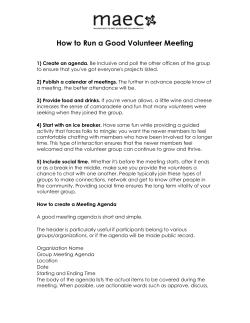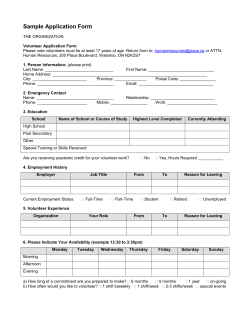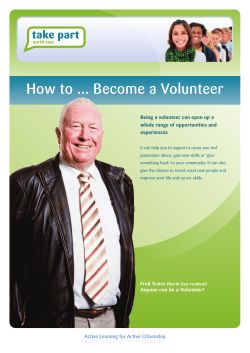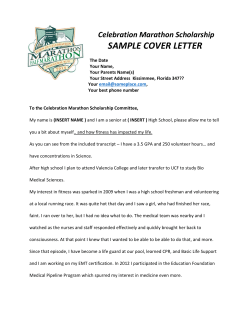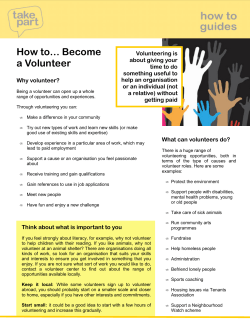
Situation Manual i 2014 S
Situation Manual 2014 SPONTANEOUS VOLUNTEER MANAGEMENT PLAN TTX U.S. DEPARTMENT OF HOMELAND SECURITY i PUBLISHING DATE: 02/26/2014 Page EXERCISE DATE: FEBRUARY 26, 2014 This page is intentionally blank. www.wmmrc.org Agawam Medical Reserve Corps (MRC) Situation Manual 2014 Spontaneous Volunteer Management Plan Exercise Phase II: Tabletop Exercise PREFACE The 2014 Spontaneous Volunteer Management Plan (SVMP) Tabletop Exercise is sponsored by the Agawam Medical Reserve Corps (MRC) through a Citizen Corps Program (CCP) grant award administered by the Massachusetts Emergency Management Agency (MEMA.) Response partners representing Citizen Corps Programs (including MRC, CERT, DART,) local health departments, regional health coalitions, public safety, MEMA, community and faith-based volunteer organizations and health care facilities have contributed to the development of the Spontaneous Volunteer Management Plan. Extensive research, regional focus groups and templates for the Plan, Just-in-Time Annex and Job Action sheets were made possible through an Emergency Management Performance Grant (EMPG) to the Region 1 – Western Massachusetts Medical Reserve Corps Advisory Group (MAG) in 2013. This Situation Manual was produced with input, advice, and assistance from participants in the January 29, 2014 SVMP Workshop conducted at MEMA Region III/IV offices in Agawam, Massachusetts which followed guidance from the Homeland Security Exercise and Evaluation Program (HSEEP.) The 2014 Spontaneous Volunteer Management Plan Tabletop Exercise Situation Manual provides exercise participants with all the necessary tools for their roles in the exercise. It is tangible evidence of Western Massachusetts’ commitment to ensure public health and safety through collaborative partnerships that will prepare the region to respond to any emergency. The 2014 Spontaneous Volunteer Management Plan Tabletop Exercise is an unclassified exercise. Control of exercise information is based on public sensitivity regarding the nature of the exercise rather than actual exercise content. Some exercise material is intended for the exclusive use of exercise planners, facilitators, and evaluators, but players may view other materials that are necessary to their performance. All exercise participants may view the Situation Manual. All exercise participants should use appropriate guidelines to ensure proper control of information within their areas of expertise and protect this material in accordance with current jurisdictional directives. CUSTOMIZING THE SITUATION MANUAL The Situation Manual is a tool for use in planning and conducting the tabletop exercise. It is designed to be customized by exercise planners for each organization/jurisdiction’s needs. The tabletop exercise is discussion based and is divided into modules, each covering key information and questions that may be addressed during the exercise. Exercise planners are encouraged to expand both the scenario and the questions to better address each entity’s exercise objectives. i www.wmmrc.org Agawam Medical Reserve Corps (MRC) Situation Manual 2014 Spontaneous Volunteer Management Plan Exercise Phase II: Tabletop Exercise Exercise planners may elect to use some or all of the modules based on time constraints, exercise participants and level of preparedness within the jurisdiction. Throughout the Situation Manual, there are opportunities for customization by organization/jurisdiction planners. Exercise planners can input their customized language, and then remove the highlight as the Situation Manual and Exercise are intended to be replicated for further training purposes. Some areas may not apply to an organization/ jurisdiction and can be deleted. Additional information specific to the organization/ jurisdiction may be added by the exercise planner. Each module section begins with a problem or issue based on the scenario. This scenario opens with language provided in the tabletop exercise guidebook. Following the initial scenario exercise planners may provide a more detailed discussion customized to that organization/jurisdiction’s needs. Exercise planners may delete the additional sections if they do not wish to create additional exercise discussion. ii www.wmmrc.org Agawam Medical Reserve Corps (MRC) HANDLING INSTRUCTIONS 1. The title of this document is the 2014 Spontaneous Volunteer Management Plan Tabletop Exercise Situation Manual. Information gathered in this Situation Manual is designated as For Official Use Only (FOUO). Reproduction of this document, in whole or in part, is at the discretion of the exercise planner for the local/operational area Western Massachusetts. 2. At a minimum, the attached materials will be disseminated strictly on a need-to-know basis. For more information about the exercise, please consult the following points of contact: Organizational/Jurisdictional Exercise Director: Kathleen Conley Norbut, M.Ed., LMHC MRC Coordinator Western Mass-Point of Contact Kccs2010@gmail.com (413) 454-5163 Agawam MRC Director Randall White, RS Health Agent Agawam Health Department 36 Main Street Agawam, MA 01001 rwhite@agawam.us Tel. 413 726-9721 FAX 413 726-9723 iii www.wmmrc.org Agawam Medical Reserve Corps (MRC) Situation Manual 2014 Spontaneous Volunteer Management Plan Exercise Phase II: Tabletop Exercise Contents Preface................................................................................................................. i Handling Instructions…...................................................................................................... ii Introduction......................................................................................................... 1 Background ................................................................................................................................................1 Purpose ......................................................................................................................................................1 Scope ..........................................................................................................................................................1 Target Capabilities ..................................................................................................................................... 1 Exercise Objectives .....................................................................................................................................2 Participants .................................................................................................................................................3 Exercise Structure .......................................................................................................................................3 Exercise Guidelines .....................................................................................................................................3 Assumptions and Artificialities ................................................................................................................... 3 Exercise Schedule ........................................................................................................................................4 Modules ....................................................................................................................................................5-9 Appendix A Appendix B ................................................................................................................................. www.wmmrc.org Agawam Medical Reserve Corps (MRC) Situation Manual 2014 Spontaneous Volunteer Management Plan Exercise Phase II: Tabletop Exercise INTRODUCTION Background The Region 1 – Western Massachusetts MRC Advisory Group (MAG) was awarded Emergency Management Performance Grant dollars through MEMA in 2013 to develop a Spontaneous Volunteer Management Plan (SVMP) for the region. The Agawam MRC unit was awarded Citizen Corps Program (CCP) grant dollars in 2014 to design, conduct and evaluate the regional spontaneous volunteer management plans through a Workshop and tabletop exercise. The tabletop exercise is being conducted to reveal strengths and gaps in local, regional and statewide plans. Purpose The purpose of this exercise is to provide participants an opportunity to evaluate current response concepts, plans and capabilities in response to a possible spontaneous volunteer surge due to a large-scale emergency or disaster. The exercise will focus on local and regional coordination of the Spontaneous Volunteer Management Plan (SVMP), critical decisions and integration with existing plans and resources. Scope In this 2.5 hour tabletop exercise alert and notification, decision‐making processes, interagency coordination will be discussed and evaluated in response to severe weather that overwhelms a local region. Exercise players will include first responders, Citizen Corps leaders and volunteers (CERT, DART and MRC), emergency management, public health officials, American Red Cross (ARC) and other organizations identified within each region. All participating jurisdictions will assume the role of their impacted area. Target Capabilities The National Planning Scenarios and the establishment of the National Preparedness Priorities have steered the focus of homeland security toward a capabilities‐based planning approach. Capabilities‐based planning focuses on planning under uncertainty, since the next danger or disaster can never be forecast with complete accuracy. Therefore, capabilities‐based planning takes an all‐hazards approach to planning and preparation which builds capabilities that can be applied to a wide variety of incidents. States and Urban Areas use capabilities‐based planning to identify a baseline assessment of their homeland security efforts by comparing their current capabilities against the Target Capabilities List (TCL) and the critical tasks of the Universal Task List (UTL). This approach identifies gaps in current capabilities and focuses efforts on identifying and developing priority capabilities and tasks for the jurisdiction. The capabilities listed below have been selected by the SVMP TTX planning team. These capabilities provide the foundation for development of the exercise objectives and scenario, as the purpose of this exercise is to measure and validate performance of these capabilities and their associated critical tasks. • Communications • Incident Command System • On‐site Spontaneous Volunteer Management 1 www.wmmrc.org Agawam Medical Reserve Corps (MRC) Situation Manual 2014 Spontaneous Volunteer Management Plan Exercise Phase II: Tabletop Exercise Exercise Objectives Exercise design objectives are focused on improving understanding of a response concept, identifying opportunities or problems, and/or achieving a change in attitude. The exercise will focus on the following design objectives: Objectives Assess the adequacy of local and regional plans that detail a response to spontaneous volunteers presenting in the immediate aftermath of a large-scale emergency or disaster. Discuss the decision‐making process regarding activating a volunteer management system and volunteer reception center. Discuss the decision‐making process regarding the management of multiple volunteer response organizations. Clarify, evaluate or resolve any questions related to interagency coordination and integration. Identify shortfalls in resources, limits in capabilities and any conflicts in the SVMP. 2 www.wmmrc.org Agawam Medical Reserve Corps (MRC) Situation Manual 2014 Spontaneous Volunteer Management Plan Exercise Phase II: Tabletop Exercise Participants • Players respond to the situation presented based on expert knowledge of response procedures, current plans and procedures, and insights derived from training. • Observers support the group in developing responses to the situation during the discussion; however, they are not participants in the moderated discussion period. • Facilitators provide situation updates and moderate discussions. They also provide additional information or resolve questions as required. Key planning committee members may also assist with facilitation as subject matter experts (SMEs) during the tabletop exercise. Exercise Structure This will be a basic, moderated tabletop exercise. Information will be provided to all players at the same time. Players will participate in the following 3 distinct modules: • Module 1: Initial Response (0-72 hours) • Module 2: On‐going Response (72 hours – day 5) • Module 3: Interagency Coordination (0 – day 5) • Module 4: Hot Wash Each module will begin with a situation briefing or update and will offer a list of questions for discussion. Participants should feel free to openly ask questions of other players, express thoughts and/or opinions. The facilitator and evaluators will capture the responses. Exercise Guidelines • This is an open, low‐stress, no‐fault environment. Varying viewpoints, even disagreements, are expected. • Respond based on your knowledge of current plans and capabilities (i.e., you may use only existing assets) and insights derived from training. • Decisions are not precedent setting and may not reflect your organization’s final position on a given issue. This is an opportunity to discuss and present multiple options and possible solutions. • Issue identification is not as valuable as suggestions and recommended actions that could improve response and preparedness efforts. Problem‐solving efforts should be the focus. • Assume cooperation and support from other responders and agencies. • The situation updates, written material and resources are the basis for discussion. There are no situational injects. Assumptions and Artificialities In any exercise a number of assumptions and artificialities may be necessary to complete play in the time allotted. During this exercise, the following apply: • The scenario is plausible, and events occur as they are presented. • There is no “hidden agenda”, nor any trick questions. • All players receive information at the same time. 3 www.wmmrc.org Agawam Medical Reserve Corps (MRC) Situation Manual 2014 Spontaneous Volunteer Management Plan Exercise Phase II: Tabletop Exercise Exercise Schedule 9:00-9:30am Registration 9:30‐9:45am Welcome and Introductions • Overview (power point presentation) • Break into groups 9:45‐10:30am Module 1‐Initial Response • Situation Briefing • Activation, Communication, Incident Command Structure • Facilitated Discussion 10:30‐11:15am Module 2‐Ongoing Response • Situation Briefing • Facilitated Discussion 11:15‐11:45am Module 3‐Interagency Coordination • Situation Briefing • Facilitated Discussion 11:45-12:00pm Module 4-Hot Wash • Provide two strengths in current plans and processes • Provide two changes that should be considered to improve current plans and processes 4 www.wmmrc.org Agawam Medical Reserve Corps (MRC) Situation Manual 2014 Spontaneous Volunteer Management Plan Exercise Phase II: Tabletop Exercise MODULE 1: INITIAL RESPONSE Scenario Events 9:00am It has been a stormy morning across the northeast and New England. The area has been hit with several severe thunderstorms. National Weather Service (NWS) in upstate NY reported receiving information that 2-3 damaging tornados made landfall in various sectors of the Capital region. Tornado Watch for Western Mass has been upgraded to Tornado Warnings. A HHAN alert has been issued and a partial activation of SEOC in Framingham has been made including staffing of ESF-6, 7, 8 desks. 9:45am Initial news reports indicate that a 1/2 mile wide EF3 tornado has ripped through a sparsely populated rural part of the county headed toward the densely populated urban centers. MEMA and local emergency management have alerted municipal officials of the potential for imminent and widespread impacts. Emergency Medical Service (EMS) has been notified that a multi-vehicle crash on route 91 has occurred due to sudden hazardous driving conditions including wind gusts estimated at over 145mph. Victims are expected to be transported to area hospitals for serious injuries. 12:00pm-72hours Media and First Responders report the following impacts and casualties: • State of emergency has been declared by the Governor • Local EOCs have been activated • First Responders have requested Mutual Aid • Three additional vehicular accidents reported along the route of the tornadoes – preliminary estimates >15 patients to ER in serious and critical condition • Power outages with transformers and power lines disrupted affecting over 350,000 residents across the region • Multiple residences, businesses and other structures have been partially or completely destroyed • The hospital inpatient beds are at 80% capacity and there are several patients waiting in the Emergency Department (ED) to be admitted • Shelter will be needed for an estimated 500 displaced persons across the county based on preliminary impact reports • Schools were in session – no reports of damage to school facilities have been received • Delays in student release were ordered in four communities due to road conditions until 8pm • The storm system dissipated within 2 hours; winds remain blustery with many roads blocked with downed trees and other debris during the first eight hours (1600 hrs) • First responders quickly became overwhelmed with calls from the public requesting information about damage, and how they can help 5 www.wmmrc.org Agawam Medical Reserve Corps (MRC) Situation Manual 2014 Spontaneous Volunteer Management Plan Exercise Phase II: Tabletop Exercise Points of Discussion: • Who is the Incident Commander? • What other IC positions roles would be activated during this response period? • What communications have been established and with whom? • Several communities have requested assistance to open and staff community shelters‐‐‐how would this be communicated and shared? • What safety and security issues are being addressed? • What do community partners expect from affiliated volunteers (ARC, MRC, CERT, DART, other) at this point? • At what point would community/faith-based groups become engaged? • How will you communicate with partners to determine your (organization’s) role? 6 www.wmmrc.org Agawam Medical Reserve Corps (MRC) Situation Manual 2014 Spontaneous Volunteer Management Plan Exercise Phase II: Tabletop Exercise MODULE 2: ONGOING RESPONSE Scenario Events: 72 hours – 5 days • 275 residents have sought temporary shelter in 6 facilities in 4 different communities • First responders continue to be overwhelmed with calls from the public requesting information about damage, and how they can help • Officials on local, state and federal levels are engaged • Affiliated volunteer groups have deployed to staff shelters • Members of the public are presenting at the impact sites stating that they want to help with the clean-up or assist in any way needed • Power and cell phones are not reliable due to system overload and damage to infrastructure. 85% of power loss has been restored by end of day three • Utility crews are deployed and working on affected regions Points of Discussion: • What Incident Command System would be in place and who would make those decisions? (Incident Command System (ICS) / Unified Command System (UCS)) • Have residents and business owners in the impact zones been asked to evacuate vs. Shelter in Place? Who would make those decisions? • Affiliated volunteer staffing resources are limited. Have outside affiliated groups been requested? Who makes that decision and how is it communicated to and from IC/UCS/EOC? • Does your volunteer organization have the personnel to staff multiple shifts at multiple locations over a period of 5 days/nights? • Are spontaneous volunteers being accepted as they show up or are they being asked to report to a VRC? • Has media been alerted with Spontaneous Volunteer and donation management directions? • Are one or more Volunteer Reception Center(s) VRC opened and staffed? • Who decides to open VRC and what entities will staff, supply and be legally responsible for VRC? • Who will craft and deliver the messaging to media, public and community members – using what tools? • Has the public been instructed to call Mass211 or another information line for nonemergency calls? If yes, who/what entity issued those instructions? 7 www.wmmrc.org Agawam Medical Reserve Corps (MRC) Situation Manual 2014 Spontaneous Volunteer Management Plan Exercise Phase II: Tabletop Exercise MODULE 3: Interagency Coordination 0 hours – 5 days A State of Emergency has been declared by the Governor • Spontaneous unaffiliated volunteers have congregated at a centrally located church and self-deploy with food, water and tools for debris cleanup and tree removal • Safety officers advise against allowing the public to roam through the impacted areas • Initial shock is beginning to wear off and people are exhausted, stressed, fearful and confused • Local affiliated volunteers are anxious about their own families and homes • American Red Cross, MRC and CERT, Ham radio operators, United Way, Salvation Army and other affiliated volunteers are active in response • Volunteer Reception Center(s) are activated Points of Discussion: • What is your agency’s role in Volunteer Reception Center (VRC) activation, staffing, supply, communication, de-mobilization? • What are your agencies and your staff needs to be able to participate in Volunteer Reception Center (VRC) operations? • Is there a standardized method of communicating and reporting information throughout the incident? 8 www.wmmrc.org Agawam Medical Reserve Corps (MRC) Situation Manual 2014 Spontaneous Volunteer Management Plan Exercise Phase II: Tabletop Exercise MODULE 4: HOT WASH Points of Discussion: • Identify two Strengths in Plans and Processes _______________________________________________________________________ _______________________________________________________________________ _______________________________________________________________________ • Recommended two Improvements to Plans and Processes _______________________________________________________________________ _______________________________________________________________________ _______________________________________________________________________ • List Any Significant Findings _______________________________________________________________________ _______________________________________________________________________ _______________________________________________________________________ • List Any Questions that Remain Unanswered _______________________________________________________________________ Conclusion of Discussion-Based Tabletop 9 www.wmmrc.org Agawam Medical Reserve Corps (MRC) Situation Manual 2014 Spontaneous Volunteer Management Plan Exercise Phase II: Tabletop Exercise This page is intentionally blank. www.wmmrc.org Agawam Medical Reserve Corps (MRC) Situation Manual 2014 Spontaneous Volunteer Management Plan Exercise Phase II: Tabletop Exercise APPENDIX A: ACRONYM LIST ARC AMERICAN RED CROSS COAD COMMUNITY ORGANIZATIONS ACTIVE IN DISASTERS EOC EMERGENCY OPERATION CENTER ESF EMERGENCY SUPPORT FUNCTION HSEEP HOMELAND SECURITY EXERCISE AND EVALUATION PROGRAM IC INCIDENT COMMAND MEMA MASSACHUSETTS EMERGENCY MANAGEMENT AGENCY MMS MASSACHUSETTS MEDICAL SOCIETY MEP MASTER EXERCISE PRACTITIONER www.wmmrc.org Agawam Medical Reserve Corps (MRC) Situation Manual 2014 Spontaneous Volunteer Management Plan Exercise Phase II: Tabletop Exercise MRC MEDICAL RESERVE CORPS NWS NATIONAL WEATHER SERVICE POC POINT OF CONTACT SE SOUTHEAST SEOC STATE EMERGENCY OPERATIONS CENTER SITMAN SITUATION MANUAL TCL TARGET CAPABILITIES LIST TTX TABLETOP EXERCISE UTL UNIVERSAL TASK LIST UC UNIFIED COMMAND www.wmmrc.org Agawam Medical Reserve Corps (MRC) Situation Manual 2014 Spontaneous Volunteer Management Plan Exercise Phase II: Tabletop Exercise UWPV UNITED WAY PIONEER VALLEY VOAD VOLUNTEER ORGANIZATIONS ACTIVE IN DISASTERS (NATIONAL PRESENCE) VMS VOLUNTEER MANAGEMENT SYSTEM VRC VOLUNTEER RECEPTION CENTER www.wmmrc.org Agawam Medical Reserve Corps (MRC) Situation Manual 2014 Spontaneous Volunteer Management Plan Exercise Phase II: Tabletop Exercise APPENDIX B: PARTICIPANT FEEDBACK FORM Please enter your responses in the form field or check box after the appropriate selection. Name: Title: Agency: Role: Player Facilitator Observer Evaluator Part I: Recommendations and Corrective Actions 1. Based on the discussions today and the tasks identified, list the top three strengths and/or areas that need improvement. 1. 2. 3. 2. Identify the action steps that should be taken to address the issues identified above. For each action step, indicate if it is a high, medium, or low priority. Corrective Action Priority 3. Describe the corrective actions that relate to your area of responsibility. Who should be assigned responsibility for each corrective action? Corrective Action www.wmmrc.org Recommended Assignment Agawam Medical Reserve Corps (MRC) Situation Manual 2014 Spontaneous Volunteer Management Plan Exercise Phase II: Tabletop Exercise 4. List the policies, plans, and procedures that should be reviewed, revised, or developed. Indicate the priority level for each. Item for Review Priority Part II: Assessment of Exercise Design and Conduct Please rate, on a scale of 1 to 5, your overall assessment of the exercise relative to the statements provided below, with 1 indicating strong disagreement with the statement and 5 indicating strong agreement. Strongly Disagree Assessment Factor Strongly Agree The exercise was well structured and organized. 1 2 3 4 5 The exercise scenario was plausible and realistic. 1 2 3 4 5 The multimedia presentation helped the participants understand and become engaged in the scenario. 1 2 3 4 5 The facilitator(s) was knowledgeable about the material, kept the exercise on target, and was sensitive to group dynamics. 1 2 3 4 5 The Situation Manual used during the exercise was a valuable tool throughout the exercise. 1 2 3 4 5 Participation in the exercise was appropriate for someone in my position. 1 2 3 4 5 The participants included the right people in terms of level and mix of disciplines. 1 2 3 4 5 Part III: Participant Feedback What changes would you make to this exercise? Please provide any recommendations on how this exercise or future exercises could be improved or enhanced. www.wmmrc.org Agawam Medical Reserve Corps (MRC)
© Copyright 2025
